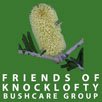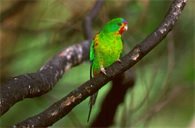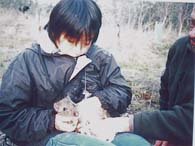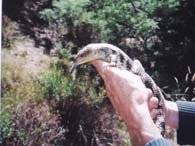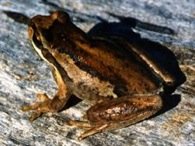A range of fauna have been identified, ranging through birds, frogs, reptiles, and marsupials. Over the past eight years, the presence of these fauna have been detected by:
Actions such as plantings, pond restorations, and weed removal have helped to improve the habitat of these fauna and encourage numbers and varieties to prosper on the reserve .
|
Bird
Name |
Comment |
|
1. Brown Quail |
Found in areas of thick grass |
|
2. Australian Wood Duck |
Grazes near water, often perches in trees |
|
3. Pacific Black Duck |
Very common and abundant |
|
4. White Bellied Sea Eagle |
Occasionally seen overflying Knocklofty |
|
5. Brown Goshawk |
Secretive but widespread and common |
|
6. Grey (White) Goshawk |
Regularly seen Knocklofty
and W.Hobart |
|
7. Collared sparrowhawk |
Looks simial to
Brown Goshawk but smaller |
|
8. Wedge-tailed Eagle |
Sometimes seen near Mt. Wellington |
|
9. Brown Falcon |
Common. Brown tear stripe is diagnostic |
|
10. Australian Hobby |
A rare visitor; very rapid in flight |
|
11. Peregrine Falcon |
A powerful flyer |
|
12. Tasmanian Native Hen |
Tasmanian endemic |
|
13. Masked Lapwing |
Commonly called Spurwing
Plover |
|
14. Pacific Gull |
Associated with McRobies
Gully Tip |
|
15. Kelp Gull |
“ |
|
16. Silver Gull |
“ |
|
17. Spotted Turtle Dove |
Call a mellow coo or coo coo |
|
18. Common Bronzewing |
Call a very monotonous oom-oom |
|
19. Brush Bronzewing |
Brown stripe through eye is diagnostic |
|
20. Yellow tailed Black Cockatoo |
Regularly seen in banksias near reservoir |
|
21. Sulphur
crested Cockatoo |
Regularly seen on Knocklofty
and in West Hobart |
|
22. Musk Lorikeet |
Noisy flocks frequently seen feeding on
blossom |
|
23. Green Rosella |
Tasmanian endemic |
|
24. Eastern Rosella |
Red head and chest |
|
25. Swift Parrot |
Migratory. Numbers declining (endangered)
but regularly seen on Knocklofty in spring/summer |
|
26. Pallid Cuckoo |
Migratory – largest of Tasmnia’s cuckoos |
|
27. Fan-tailed Cuckoo |
Like all our cuckoos unable to make nest |
|
28. Horsfield’s
Bronze Cuckoo |
Uncommon migrant |
|
29. Shining Bronze Cuckoo |
Metallic green bronze colouring |
|
30. Southern Boobook |
Often hear calling boo-book or mo-poke |
|
31. Masked Owl |
Rarely seen seeding near street lights |
|
32. Tawny Frogmouth |
Regularly seen feeding near street lights |
|
33. White throated Needletail |
Often seen in large flocks in late
summer/early autumn |
|
34. Laughing Kookaburra |
Introduced into Tasmnania |
|
35. Superb Fairy Wren |
Common on Knocklofty |
|
36. Spotted Pardalote |
Monotonous high pitched sleep baby call |
|
37. Striated Pardalote |
Repetitive pick-id-up call |
|
38. Brown Thornbill |
Very busy. Often seen in the canopy |
|
39. Tasmanian Thornbill |
More common in wetter sites |
|
40. Yellow-rumped
Thornbill |
Largest thornbill.
Regularly seen in groups feeding on the ground |
|
41. Yellow Wattlebird |
Largest honeyeater. Endemic |
|
42. Little Wattlebird |
Heavily white streaked plumage |
|
43. Noisy Minor |
Often in noisy, aggressive flocks |
|
44. Yellow-throated Honeyeater |
Very common endemic |
|
45. Strong-billed Honeyeater |
White eyestripe
flocks. Endemic |
|
46. Blackheaded
Honeyeater |
Often in noisy flocks. Endemic |
|
47. Crescent Honeyeater |
Egypt
call |
|
48. New Holland Honeyeater |
Streaked black & white plumage with
yellow wing patch |
|
49. Eastern Spinebill |
Rufous colouring |
|
50. Scarlet Robin |
Most common robin on Knocklofty |
|
51. Flame Robin |
Partly migratory |
|
52. Pink Robin |
Prefers wet forest |
|
53. Dusky Robin |
Larger & more robust appearance
compared to other robins |
|
54. Olive Whistler |
Low sweet whistle often with whipcrack at the end |
|
55. Golden Whistler |
Males have beautiful yellow plumage |
|
56. Grey Shrike Thrush |
Beautiful joe whitty call |
|
57. Satin flycatcher |
Common summer migrant |
|
58. Grey fantail |
Sometimes known as Cranky Fan |
|
59. Black-faced Cuckoo Shrike |
Common summer migrant. Shuffles wings on
alighting |
|
60. Dusky Woodswallow |
Common summer migrant. |
|
61. Grey Butcherbird |
Common resident |
|
62. Australian Magpie |
|
|
63. Black Currawond |
Common endemic |
|
64. Grey Currawong |
Common nomadic. Clinking call |
|
65. Forest Raven |
|
|
66. House Sparrow |
Introduced in 19th Century |
|
67. Beautiful Firetail |
Red rump is diagnostic |
|
68. Greenfinch |
Looks like a canary. Introduced |
|
69. Goldfinch |
Introduced in 1880’s. Red, black, yellow
and white markings |
|
70. Welcome Swallow |
Common summer migrant. Forked tail |
|
71. Tree Martin |
Common summer migrant. Square tail |
|
72. Silver Eye |
White eye ring |
|
73. Ground Thrush |
Common resident. Prefers wet forest |
|
74. Blackbird |
Introduced to Tasmania in 1930’s |
|
75. Starling |
Introduced to Tasmania in 1860 |

